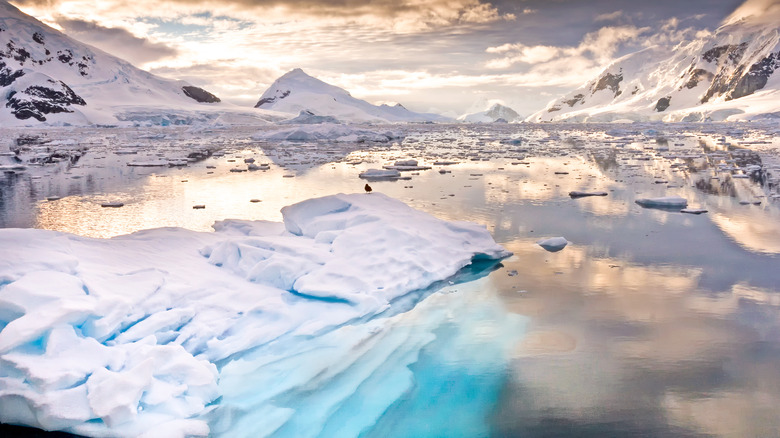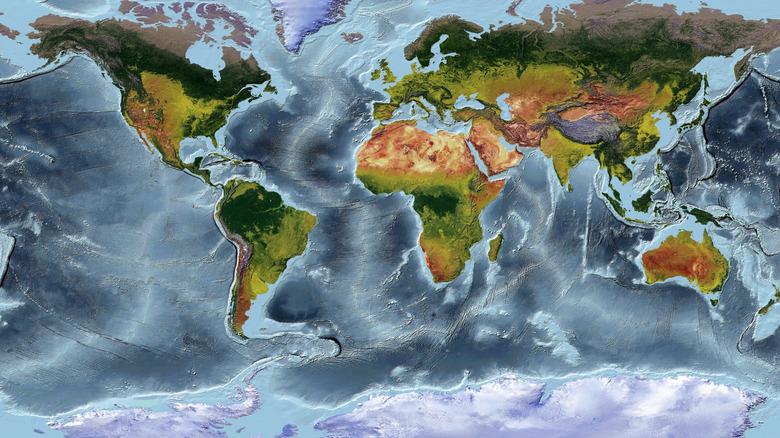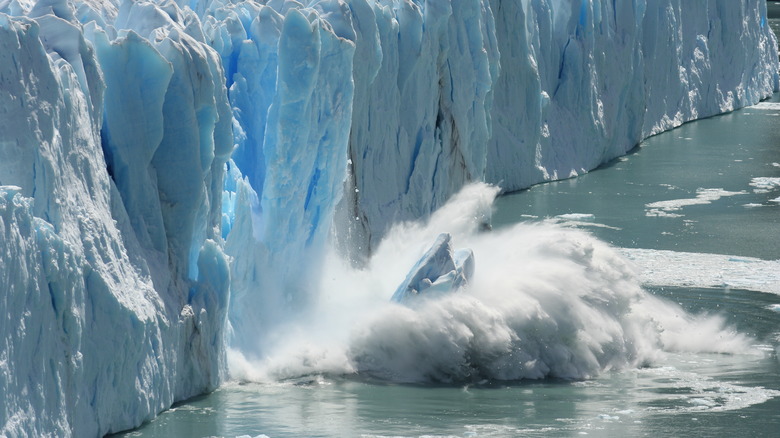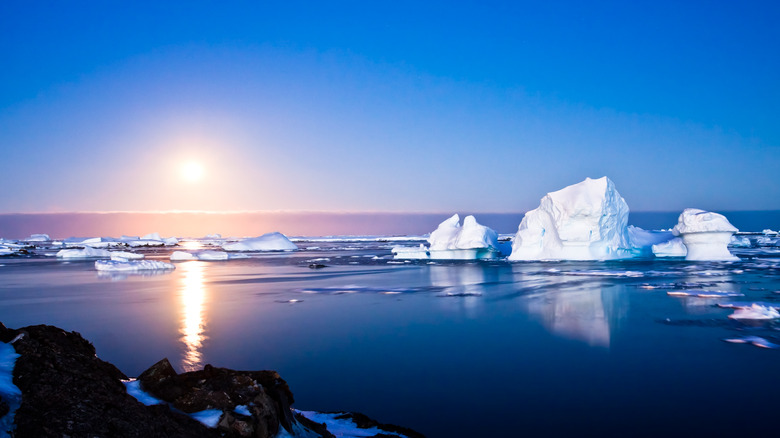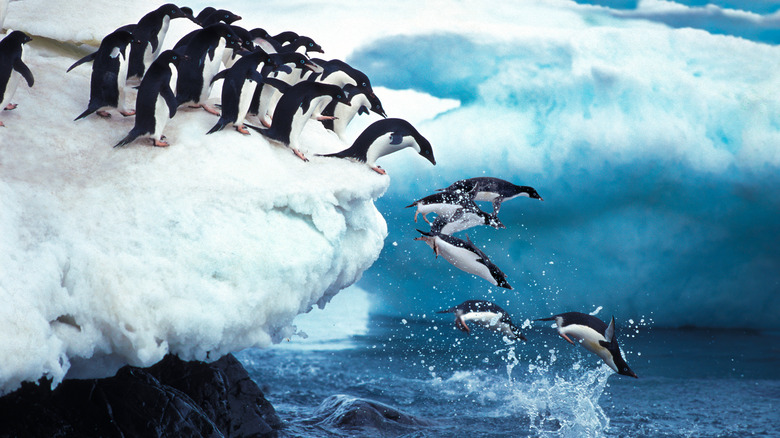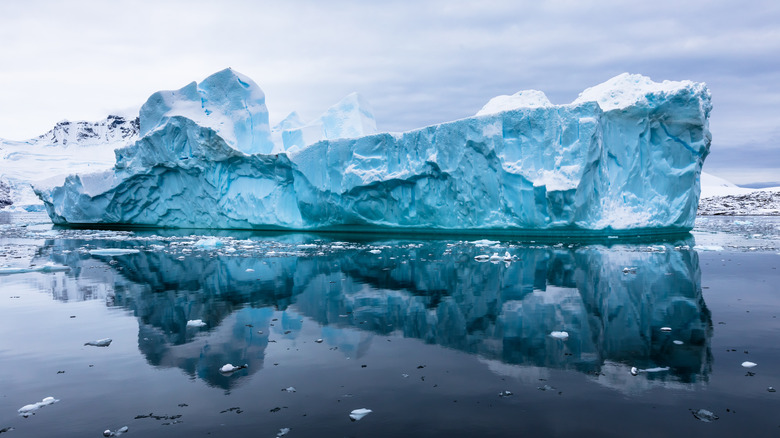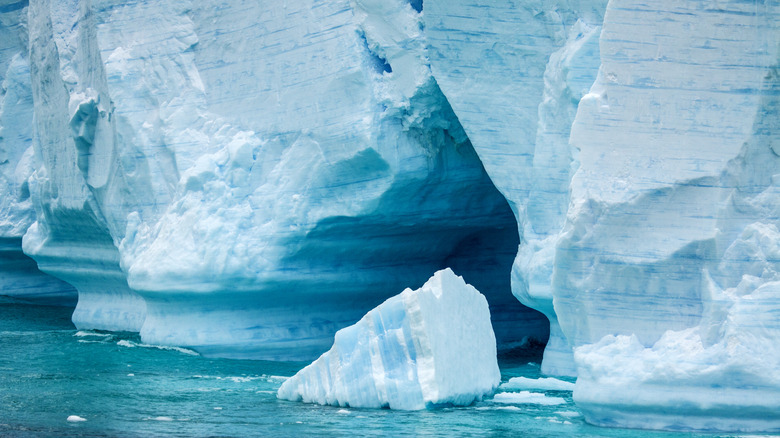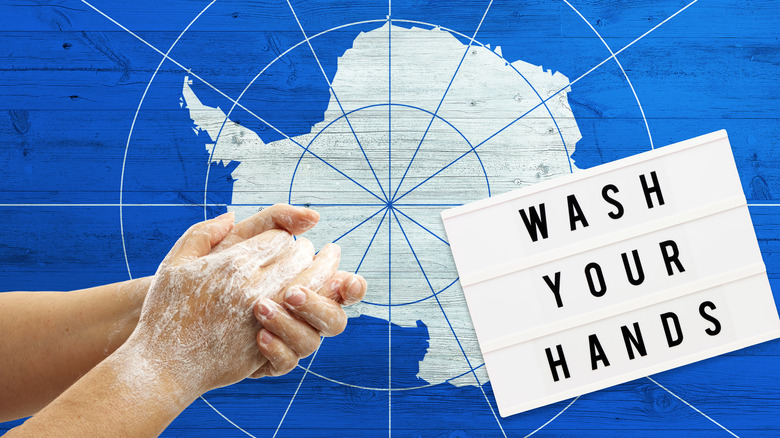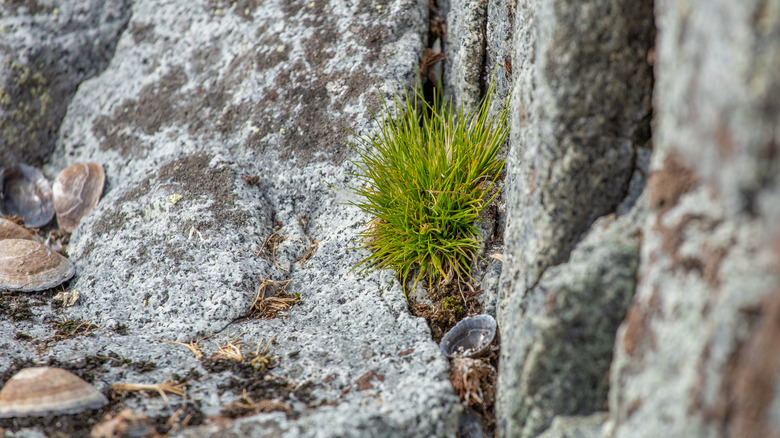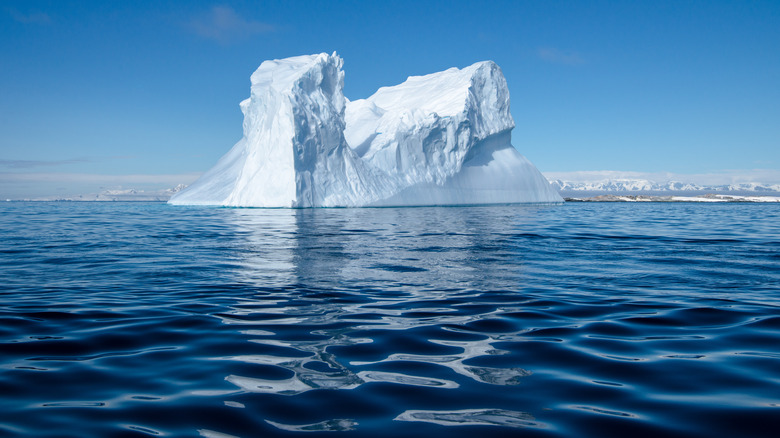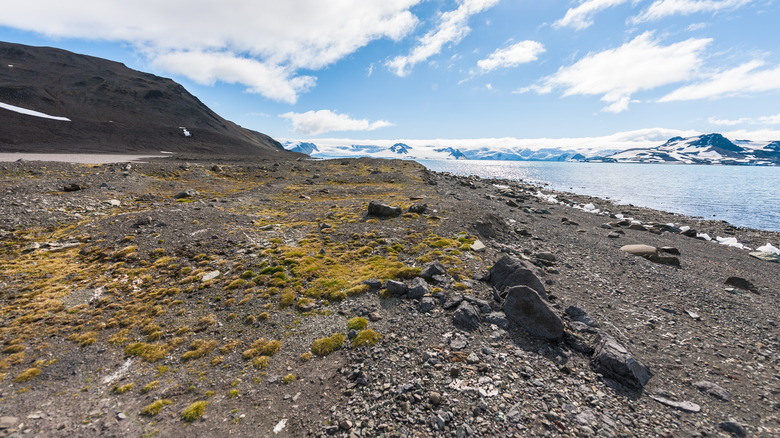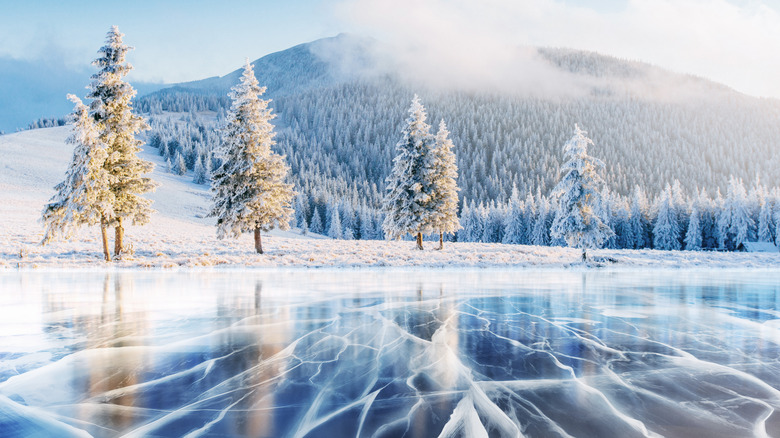Here's What Would Happen If Antarctica Melted
The farther along we get in the grand scheme of things, in a world where climate change is up for debate and a move to reduce global emissions is quickly reaching a point of "too little, too late," National Geographic says we're looking at a case of not just what "might" happen if all the ice in Antarctica were to melt, but at what "will" happen.
And there's a lot of ice to melt. According to the National Snow & Ice Data Center, Antarctica's ice sheet covers somewhere around 14 million square miles. To put that another way, if that got picked up and plopped down in North America, it would cover all of the US and Mexico. Then, there's the depth. When that's figured into the equation, it adds up to around 7.2 million cubic miles of ice.
All that ice has taken thousands of years to build up, and thanks to the emissions of an ever-growing, ever-industrialized world, it's estimated that without massive changes, the world will be facing a massive ice melt by 2060. That means all kinds of terrible things are going to happen, so let's look at just what the world is in store for.
Gravity would do weird things
It's pretty obvious that all Antarctica's melting ice would get dumped into the oceans and make the sea levels rise, but it's not that straightforward. Massey University applied mathematics professor Robert McLachlan says (via The Conversation) that there's some insanely complicated stuff going on, but here's the basics. For starters, the disappearance of the ice means that there's going to be a shift in gravity. That gravitational change will be great enough that it'll actually make the land expand and ultimately rise in some areas, which will make the rise in water not-as-bad. It'll still be bad, but it won't be bad on a scale of global equality.
Way back in 1875, a scientist named James Croll explained the whole thing with some mathematical calculations. He determined that instead of sea levels rising in a uniform way, the so-called "gravity effect" would mean levels around Antarctica would actually rise about a third less than the global average, while that difference would be made up in the northern hemisphere, which would see sea levels rise by as much as a third above the average.
A few years later, another mathematician did more calculations, and found that while the reach of rising and falling wasn't quite that straightforward, the principle was sound. The same works in reverse, too: The melting of Greenland's ice is going to shift gravity in the other direction, and result in lower levels of sea rise in the north, with greater in the south.
The whole thing gets a little less steady
The planet doesn't just spin on its axis, it also wobbles a bit — kind of like the guy that staggers out of the bar after having just one drink too many. The wobble is based largely on how mass is distributed across the planet, and here's where the ice comes in. Between 1899 and 2018, the Earth's axis shifted by about 34 feet — meaning that the north and south poles had both moved by that much. According to LiveScience, that's because polar ice was melting so fast it had changed the way the planet wobbles. Researchers from Jet Propulsion Laboratory estimated that about two thirds of the shift could be blamed on the disappearance of the ice, the following gravity shift, and the expansion of the land. Maybe.
Melting ice and changes to the Earth's axis have been recorded for a long, long time, but researchers aren't exactly clear on just how much of the poles' movement is the result of melting ice. There are other factors — like the movement of the lava-like mantle deep inside the earth — but that's not the end of the story.
Now, it's thought that not all of Antarctica's ice needs to melt before we see serious consequences. Paleoclimatologists from the University of Wisconsin say (via LiveScience) that it's kind of like a snowball effect. The farther the planet wobbles, the more the poles are exposed to shifting warm-water currents, and the faster the ice will melt.
Days will get just a little longer
Talking about the melting of all the ice in Antarctica means talking about a lot of hypotheticals, because until it happens, there's really no way to account for all the interconnected systems that are all working together to keep this big blue marble of ours floating through time and space. That means it's tough to come up with exact numbers, but researchers do know that when Antarctica's ice melts, it's going to change the length of a day.
Jerry Mitrovica is a Harvard University professor, and he explained the whole thing to Reuters. When ice melts, that's going to shift water — and weight. He says to imagine a figure skater spinning on the ice. When they lift and lower their arms, they shift their weight and spin either faster or slower. And that's what is going to happen to the planet. Mitrovica says it's already starting to happen, and thanks to the melting ice and the polar shift, a day has already gotten imperceptibly longer by about a thousandth of a second.
It's not clear just how much longer the day will get if all the ice was to melt, but UC Irvine glaciologist Mathieu Morlighem estimates (via Inverse) that it could change by as much as 20 seconds.
These countries and cities would disappear
The ice in Antarctica and Greenland are the biggies — when those two places melt, that's when life on Earth is going to get very, very shady. In some places, it'll simply be gone. National Geographic took a look at what each continent will look like when the sea levels stop rising, and it's not a pretty picture.
Coastal cities — like New York, New Orleans, Buenos Aires, Cairo, London, Venice, Shanghai, and Bangladesh — would all be gone, along with some majorly important swathes of land. Four-fifths of Australians live along the coast, and that entire area would be underwater — along with an area of China that's currently home to around 600 million people. Denmark and the Netherlands won't survive, they'll be almost completely underwater — along with most of the US's East Coast, Florida, and Mississippi Delta, almost all of Paraguay, and a good part of Central America. Some major places would turn into islands, like San Francisco and Cambodia.
What about Africa? While that continent might fare a little better when it comes to losing land, the rising temperatures that would go along with the ice melt would make most of it downright uninhabitable. Considering that UC Irvine glaciologist Mathieu Morlighem estimates (via Inverse) about 40% of the world's population lives in the danger zone, there's really no winning here.
A large number of species would be devastated
Antarctica might look cold and desolate, but it's actually only one of those things. It's home to a wide range of animal life, from sea birds and penguins to seals, whales, and other marine creatures. Most of them? It's not a pretty picture.
According to the Columbia Climate School, climate change will be devastating to most of the species who live there. Penguins — including Emperor and Adélie penguins — have already (as of 2015) seen a massive decrease in numbers as the ice has started to disappear. Other species — like the Chinstrap penguin — have taken their place, but the complete disappearance of ice would be devastating to pretty much everyone. The same situation goes for animals like seals and whales. Many species are considered ice-dependent, and that simply means that when the ice goes, they will, too. It'll be the end of Leopard and Ross seals, along with Minke whales.
There's a second part of this, too. Creatures like krill and phytoplankton are on the bottom of the food chain, and not only do scores of creatures rely on them, but they rely on the sea ice. Taking out the bottom rung of the food chain won't be just devastating, it would be likely to set off a chain reaction felt throughout the ecosystem.
We'll have a major problem with drinking water
Everyone who lives safely inland might find it tempting to think they're immune from the effects of the melting Antarctic ice, but UC Irvine glaciologist Mathieu Morlighem says (via Inverse) that's not the case at all. There's another huge problem that many people would suddenly have to deal with, and that's the disappearance of clean drinking water.
Morlighem says, "If the sea level is rising, there is going to be infiltration of saltwater in groundwater reserves farther inland. So, even though you may think that you're safe because you are higher than 250 [above sea level], your well may now be contaminated and you can't irrigate because it's salty water."
This is seriously the scenario that just keeps on giving more and more horrible consequences. NASA says that in 2020, the world was already seeing freshwater drinking reserves affected not just by the ice melt of not only Antarctica and Greenland, but of glaciers and ice in areas like the Russian Arctic and the Andes. Millions of people rely on the slow, regular melting of freshwater glaciers for a steady water supply, and putting stress on this delicate system is only going to end in one way — and it's not good for anyone involved.
It would release hundreds of super-durable species of microbes
If Antarctica's ice melts, it's not just going to dump a ton of water onto the planet — it's going to free everything that's been hiding underneath that ice for millions of years. In 2011, Chilean research teams were looking at just what kind of microbes were living in the Antarctic ice, and they found some surprising — and potentially terrifying — things. Their study (published in Nature) found that the microbes were well adapted to surviving life in extreme cold. No shock there, but they were also capable of surviving in environments that had super-high concentrations of salt, were super acidic, super alkaline, and included temperatures up to around 200 Fahrenheit. Oh, and one — in spite of living 50 feet beneath the ice surface — was capable of withstanding radiation levels that are 5,000 times higher than anything else on earth has been exposed to.
Researchers have no idea why some of these microbes even developed, and they say that "no theory has been discarded."
There's been a ton of controversy over the findings, but according to National Geographic, those results were supported by more samples taken from another lake. This one — buried under half a mile of ice on the West Antarctic Ice Sheet — yielded samples so wildly unlike anything else we see in the world that they were cited as proof that life could exist in the harsh conditions found in space. What'll happen when they're released? Who knows!
Yes, there's a high likelihood of releasing diseases
Scientific American says that the tiny creatures locked away in Antarctic ice haven't seen the light of day for around 750,000 years. That means they predate human life, and if there's anything we learned from the diseases Columbus and his men (and then the Spanish) carried to the New World, it's that humans get pretty soft and squishy when they're exposed to pathogens they have no immunity to.
Scientists are calling Antarctica a "storehouse for genes," and if that doesn't sound like the start of a horror movie, how about this: There are almost definitely diseases in there, too. According to a paper published by researchers from Cairo University, the thawing and subsequent revival of bacteria and viruses will have "unexpected consequences." They point to the discovery of a type of bacteria discovered in Antarctica that is 8 million years old, which makes it one of the oldest living things on the planet.
And yes, scientists know that these newly thawed bacteria can be deadly. How? It's happened in other places. Viable smallpox, bubonic plague, and anthrax has been thawed from the ice, with the latter infecting and killing across Siberia during a 2016 outbreak. The BBC says that's unlikely to be the only time it happens.
Antarctica would get much greener
With the ice, Antarctica looks like a mostly flat, barren wasteland. If the ice melts, we'd see something much different start to emerge. Glaciologists from the University of Waterloo and the University of Tasmania say (via The Conversation) that technology has finally advanced to the point where it's allowing them to map the land that's underneath the ice. They've found some incredible things, like more than 400 lakes (that are filled with actual water, not ice) that include the 6th largest in the world, Lake Vostok. There's also a vast network of rivers, and a network of canyons that make the Grand Canyon look like amateur hour for canyon designers.
All of that would be revealed, and according to researcher Matthew Amesbury of the University of Exeter (via The Washington Post), it won't just be barren. He says, "Our work shows that parts of it are green, and are likely to be getting greener."
They say that although the ice-covered Antarctic is less than 1% green, they've found traces of hardy mosses beneath the surface of that ice. As of 2017, some areas — like the aptly-named Green Island — were already covered in colorful mosses. University of Massachusetts glaciologist Rob DeConto explains: "This is another indicator that Antarctica is moving backward in geologic time — which makes sense, considering atmospheric CO2 levels have already risen to levels that the planet hasn't seen since the Pliocene, 3 million years ago, when the Antarctic ice sheet was smaller."
It'll have severe impacts on the way the oceans circulate
Let's talk about thermohaline circulation, which is — says the National Oceanic and Atmospheric Administration — the global system of deep-ocean currents. While it's the wind that really helps form surface currents, it's the poles — and the presence of ice — that creates currents deep underwater. In a nutshell, as water freezes into sea ice, that increases the saltiness of the water. That super-salty water sinks and is replaced by less salty water at the surface. That less salty water eventually freezes, and the whole process starts all over again in what they call a "global conveyor belt."
It doesn't just regulate temperature, but salinity, too. Take away the Antarctic ice sheet, and Marine Species says bad things are bound to happen. Specifically, they say that Antarctica plays a major role in essentially monitoring the circulation of salt through the Southern Oceans. While it's not clear just what impact melting ice would have, they say "the potential for changes in freshwater fluxes or salinity variations to influence the Southern Ocean is clearly evident."
Changing weather, rains, and warming oceans
In 2021, researchers from the UK Met Office and the University of Exeter released the findings (via CNN) of their study on what would happen to the planet's weather patterns if Antarctica's ice melted and revealed the terrain underneath. In short? Nothing will be the same.
They found that with the emerging land formations came major shifts in global wind patterns. That, in turn, led to "big increases in rainfall," and that has consequences of its own — specifically, adding to rising ocean temperatures. They also say that monsoon seasons would become the norm, and there's another huge problem. While the ice reflects up to 80% of the sunlight that hits it, the newly exposed land would absorb that light and heat. That would, of course, end up heating up the nearby oceans, too, which speeds up the whole process of the global climate going, what's best described as, "to hell in a handbasket."
Sounds unlikely? Researchers say they've found evidence that it's happened before, in the Middle Miocene period. Once it happens, they say "it becomes harder for a large ice sheet to reform," and all that means that the tipping point of Antarctica's ice melt situation is less "Jenga played with wooden blocks," and more "Jenga played with skyscrapers."
It'll kick off an Ice Age
So, there are a lot of things that would happen if Antarctica's ice were to melt. There's the loss of animal life, the unbalancing of everything from weather patterns and ocean currents to winds and rainfall, and the heating up of global waters. What's that all leading up to? Another Ice Age.
Wait, what? How can heat lead to an Ice Age?
The Columbia Climate School explains it like this: Icebergs have — in the past, millions of years ago — broken off from the Antarctic ice sheet and drifted well into neighboring oceans before melting. That's more than enough to set off a sort of domino effect, where the icebergs dump huge amounts of freshwater into one area and throw off the balance of salty-to-fresh on a global scale. That, in turn, makes the ocean become something of a carbon dioxide sponge, and while reducing greenhouse gases and decreasing global warming might be a good thing, it's not great when things get too cold.
Their findings that yes, this absolutely has happened before came from the analysis of a deep-water sediment core dug up about 500 miles off the coast of southern Africa. It included a sediment record for the last 1.6 million years, and they say that during every Ice Age the earth has been through, there are signs of melting Antarctic ice being involved in the whole thing. So, there's that.
